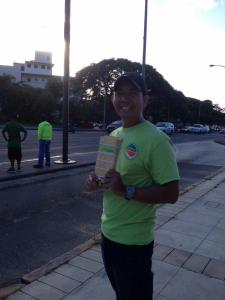A few weeks ago, my daughter’s 3rd grade teacher asked me to come to her class to speak about what it was like to grow up on a farm. They were in the midst of doing a history project to learn about something of valuable in their family. She felt that the kids would learn a thing or two hearing my stories as many kids have no idea about what it’s like to be farm kid.
In my talks to kids, I really love engaging them and asking them questions to get them to participate in the talk. I really want them to think about how their childhood compares mine as it is starkly different.
The first question I asked them was, “Who grew up on a farm?” Surprisingly, one girl raised her hand and said that she grew up for a short time in Waimanalo, which is also very rural. For the majority of the kids, none knew what it was like to grow up on the farm. I decided to expand on the stories of what I did as a kid on the farm.
I decided to ask them what kinds of toys they had and where it came from. Most said they played video games or had something bought in a store that they loved to play with. I told them that the outdoors was my playground. We didn’t have a lot of money so we weren’t loaded with toys like the kids of today are. I did have a doll and a few items but not hoards of toys. The farm was my playground. I’d toss up stones, scour trees for bugs, pick fruits and jojo beans, catch butterflies, scoop fish, ride tractors and bulldozers, and play with mud. Some kids had done some of these things, but not many.
I asked them if they ever made a toy. Most kids didn’t even think that they could make something to play with, other than Lego that is. I told them about how my dad was the expert recycler of what most people thought of as junk. He’d use an old tire and some rope and turn it into a swing for us. He would also use an inner tube from a tractor tire with a piece of plywood and turn it into a raft. Pieces of bamboo were used to make a bow and arrow that I’d shoot out in the field. Hand tools were also my toys as I could use them to make my own slingshots or other homemade gadgets from the “junks” or other stuff found outside. The wonderment in these kids’ eyes were amazing as they had never thought to do such things.
Many kids also said that they loved to watch TV. I told them how TV was not a ritual for me and my siblings growing up. Saturdays were spent waking up way early and having your lovely sleep disrupted by a busy father. He’d turn on all the lights and pull off the covers to get us out of bed to get ready for the farm. We’d spend the day working on the farm with processing the papayas, planting, or cleaning the trees.
There was no time to fool around, time was precious and valuable to keep the operations going. There were break times where my siblings and I would sneak down to the stream and catch guppies or make dams to catch tilapia. Other times we’d walk the field and dig up old relics like bumboocha marbles or other trinkets in the dirt. (I didn’t tell them about the naughties we did like learning how to light up banana leaves and turn them into fake cigarettes. That’s a sure way to stop anyone from wanting to smoke!)
I asked the kids if any had rode on a tractor before and a handful had through visits to the pumpkin patch. I shared the story about how my dad used the backhoe and graded the land and created a huge mountain of dirt. I asked if they knew what could be done with that dirt hill. One student figured it out and said, “Slide down it!” This magnificent dirt hill was a kids dream filled with soft dirt and small pebbles. My brother and I called it dog food mound and it was a daily ritual of climbing it and sliding down. Definitely a kid’s dream come true that these third graders were bubbling with excitement to hear of.
I closed my talk by reminding them to talk story with their grandmas and grandpas. I told them that they probably have some terrific stories similar to mine that they should hear. Many of these kids haven’t sat down to learn about the stories of their family. They were inspired to now go and ask them about what kind of toys their grandparents played with and what was their playground. These kids were really excited during my sharing and even more excited to go out and hear of neat stories in their own family.
By talking and sharing my stories, I’ve come to realize that the more we talk about what we do, the better other’s can appreciate it. The more we teach others and open minds to the wonders of the world and keep them curious, the more we have seekers of knowledge. We have to keep sharing our stories with the younger generations to know how and why we are so lucky to be able to do the things we can.
I had to add in one last bit of hurrah to end it. I reminded them that they can do all the things in life because someone did a great thing by learning how to feed lots of people really well. That person was a farmer and I am lucky enough to have grown up a farmer’s daughter.










